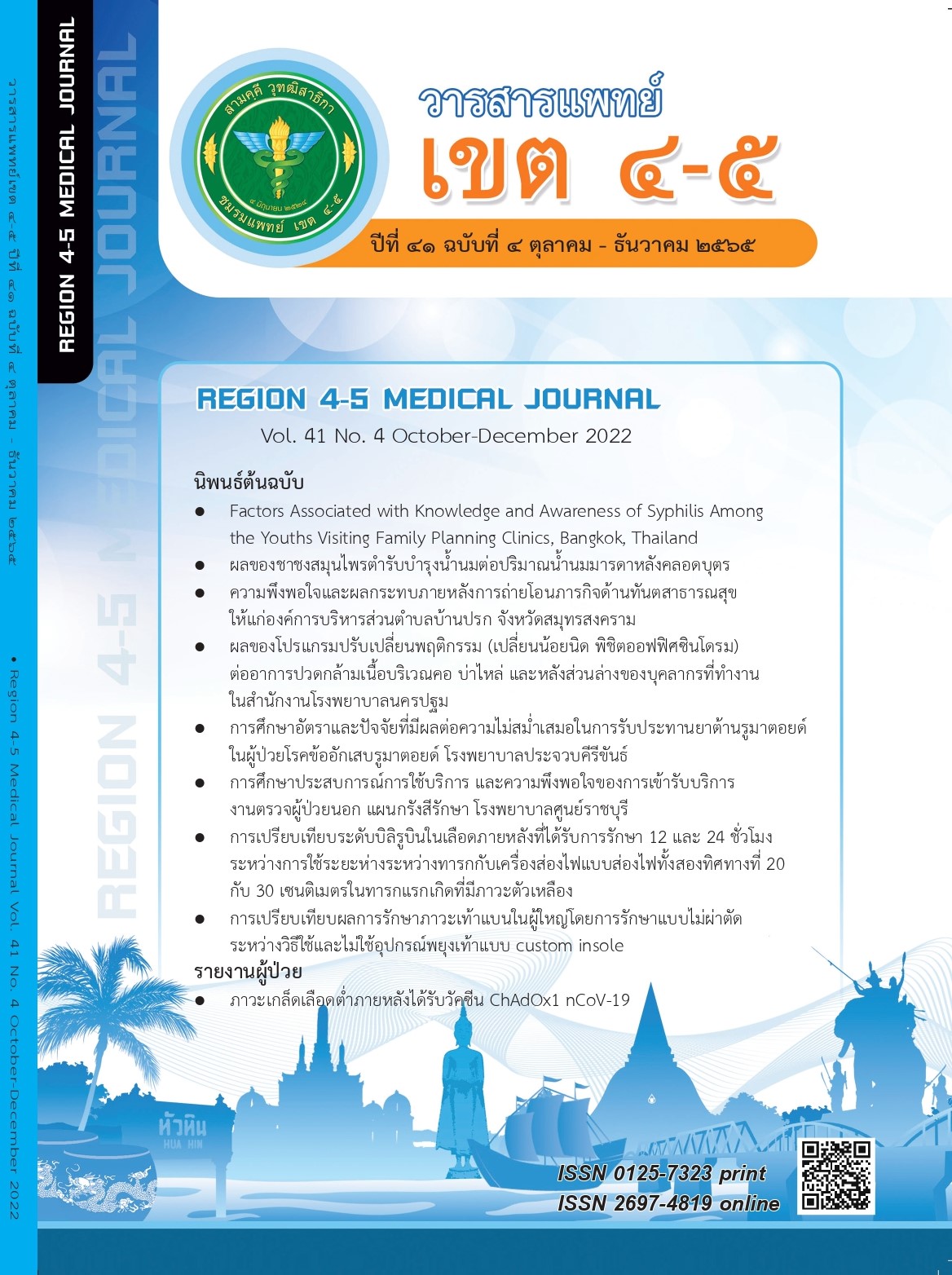การรักษามะเร็งผิวหนังชนิด Basal Cell Carcinoma บริเวณใบหน้าด้วยการผ่าตัดในโรงพยาบาลชุมชน
คำสำคัญ:
มะเร็งผิวหนัง, มะเร็งผิวหนังชนิดเบซัลเซลล์, ผ่าตัดบทคัดย่อ
มะเร็งผิวหนัง basal cell carcinoma เป็นมะเร็งผิวหนังที่พบบ่อยที่สุดของมนุษย์ทั่วโลก จากรายงานของประเทศสหรัฐอเมริกาใน ค.ศ. 2009 พบว่ามีผู้ป่วยรายใหม่มากถึง 900,000 ราย เป็นเพศชาย 550,000 ราย และหญิง 350,000 ราย สำหรับในประเทศไทยตามรายงานของสถาบันมะเร็งแห่งชาติปี พ.ศ.2559 – 2561 พบว่าจำนวนผู้ป่วยมะเร็งผิวหนังในเพศชายมีค่าเฉลี่ยอุบัติการณ์ปรับอายุมาตรฐาน (age standardized incidence rate – ASR) เท่ากับ 4 ต่อแสนประชากร ซึ่งเป็นอันดับที่ 9 ของมะเร็งที่พบในเพศชาย ส่วนในเพศหญิงพบค่าเฉลี่ยอุบัติการณ์ปรับมาตรฐานอายุ เท่ากับ 4.3 ต่อแสนประชากร ซึ่งหากผู้ป่วยได้รับการรักษาตั้งแต่ระยะเริ่มต้นก็มักจะได้รับผลการรักษาที่ดีทั้งในแง่ของโอกาสการหายและลดโอกาสการสูญเสียอวัยวะที่เกี่ยวข้อง เป้าหมายในการรักษามะเร็งผิวหนังชนิด basal cell carcinoma มีอยู่ 4 ประการด้วยกันคือ เพื่อกำจัดมะเร็งออกให้หมด รักษาเนื้อเยื่อที่ดีโดยรอบไว้ให้มากที่สุด รักษาไว้ซึ่งการทำงานที่ปกติของอวัยวะที่เกี่ยวข้อง เช่น ตา จมูก ปาก และสุดท้ายคือให้ได้ผลลัพธ์เรื่องความสวยงามที่ดีที่สุด อย่างไรก็ตามการรักษา basal cell carcinoma มีหลายวิธี ได้แก่ การผ่าตัด การจี้ไฟฟ้า การใช้ความเย็น (cryosurgery) การฉายแสง และการใช้เคมีบำบัด ซึ่งแต่ละวิธีก็มีความเหมาะสมกับลักษณะของมะเร็งที่ต่างกัน รายงานนี้ นำเสนอผู้ป่วยชาย อายุ 86 ปี เป็นมะเร็งผิวหนังชนิด basal cell carcinoma ขนาดเส้นผ่านศูนย์กลาง 1.5 เซนติเมตร บริเวณแก้มล่างด้านซ้าย ได้รับการรักษาโดยการผ่าตัด โดยผ่าตัดเอามะเร็งผิวหนังและผิวหนังปกติที่อยู่รอบเนื้อมะเร็งอีก 1 เซนติเมตรออกไปพร้อมกัน โดยคำนึงถึงโอกาสการหายและผลลัพธ์ด้านความสวยงามเป็นอย่างดี หลังผ่าตัดได้ทำการติดตามผลการรักษาเป็นระยะ จนครบ 1 ปี ผู้ป่วยมีการใช้งานกล้ามเนื้อบริเวณหน้าได้อย่างปกติ ไม่พบภาวะแทรกซ้อนและยังไม่พบการกลับเป็นซ้ำอีก
เอกสารอ้างอิง
Rogers HW, Weinstock MA, Harris AR, et al. Incidence estimate of nonmelanoma skin cancer in the United States, 2006. Arch Dermatol. 2010;146(3):283–7.
Rigel DS, Friedman RJ, Kopf AW. Lifetime risk for development of skin cancer in the U.S. population: current estimate is now 1 in 5. J Am Acad Dermatol. 1996;35(6):1012–3.
Kim DP, Kus KJB, Ruiz E. Basal Cell Carcinoma Review. Hematol Oncol Clin North Am. 2019;33(1):13–24.
Kauvar ANB, Cronin T Jr, Roenigk R, et al. Consensus for nonmelanoma skin cancer treatment: basal cell carcinoma, including a cost analysis of treatment methods. Dermatol Surg. 2015;41(5):550–571.
Medical digital division, National Cancer Institute. Cancer In Thailand Vol.X, 2016 – 2018. Bangkok :National cancer institute; 2012:40–43.
Scrivener Y, Grosshans E, Cribier B. Variations of basal cell carcinomas according to gender, age, location and histopathological subtype. Br J Dermatol. 2002;147(1):41–7.
Gallagher RP, Hill GB, Bajdik CD, et al. Sunlight exposure, pigmentary factors, and risk of nonmelanocytic skin cancer. Arch Dermatol. 1995;131(2):157–63.
Karagas MR, McDonald JA, Greenberg ER, et al. Risk of basal cell and squamous cell skin cancers after ionizing radiation therapy. For the Skin Cancer Prevention Study Group. J Natl Cancer Inst. 1996;88(24):1848–53.
Martin H, Strong E, Spiro RH. Radiation-induced skin cancer of the head and neck. Cancer. 1970;25(1):61–71.
Pack GT, Davis J. Radiation cancer of the skin. Radiology. 1965;84:436–42.
Silverberg MJ, Leyden W, Warton EM, et al. HIV infection status, immunodeficiency, and the incidence of non-melanoma skin cancer. J Natl Cancer Inst. 2013;105(5):350–60.
Lange E, Blizzard L, Venn A, et al. Disease-modifying anti-rheumatic drugs and non-melanoma skin cancer in inflammatory arthritis patients: a retrospective cohort study. Rheumatology. 2016;55(9):1594–600.
Miller SJ, Alam M, Andersen J, et al. Basal cell and squamous cell skin cancers. J Natl Compr Canc Netw. 2010;8(8):836–64.
Bath-Hextall F, Bong J, Perkins W, et al. Interventions for basal cell carcinoma of the skin: systematic review. BMJ. 2004;329(7468):705.
Mosterd K, Krekels GA, Nieman FH, et al. Surgical excision versus Mohs’ micrographic surgery for primary and recurrent basal-cell carcinoma of the face: a prospective randomised controlled trial with 5-years’ follow-up. Lancet Oncol. 2008 ;9(12):1149–56.
Fields RC, Fleming MD, Gastman B, et al. NCCN Clinical Practice Guidelines in Oncology (NCCN Guidelines) Melanoma- Version 2.[internet] 2018. [cited 2022 August 19]; Available from: URL: https://www.nccn.org/patients/guidelines/content/PDF/melanoma-patient.pdf
Codazzi D, Van Der Velden J, Carminati M, et al. Positive compared with negative margins in a single-centre retrospective study on 3957 consecutive excisions of basal cell carcinomas. Associated risk factors and preferred surgical management. J Plast Surg Hand Surg. 2014;48(1):38–43.
Sherry KR, Reid LA, Wilmshurst AD. A five year review of basal cell carcinoma excisions. J Plast Reconstr Aesthet Surg. 2010;63(9):1485–9.
Wolf DJ, Zitelli JA. Surgical margins for basal cell carcinoma. Arch Dermatol. 1987;123(3):340–4.
Barlow JO, Zalla MJ, Kyle A, et al. Treatment of basal cell carcinoma with curettage alone. J Am Acad Dermatol. 2006;54(6):1039–45.
Rowe DE, Carroll RJ, Day CL Jr. Mohs surgery is the treatment of choice for recurrent (previously treated) basal cell carcinoma. J Dermatol Surg Oncol. 1989;15(4):424–31.
Epstein E. Fluorouracil paste treatment of thin basal cell carcinomas. Arch Dermatol. 1985;121(2):207–13.
Bath-Hextall F, Bong J, Perkins W, et al. Interventions for basal cell carcinoma of the skin: systematic review. BMJ. 2004;329(7468):705.
Marcil I, Stern RS. Risk of developing a subsequent nonmelanoma skin cancer in patients with a history of nonmelanoma skin cancer: a critical review of the literature and meta-analysis. Arch Dermatol. 2000;136(12):1524–30.
Miller SJ, Maloney ME, editors. Cutaneous oncology.Pathophysiology, diagnosis and management. Malden: Blackwell Science. 1998:695–698.
Van Loo E, Mosterd K, Krekels GAM, et al. Surgical excision versus Mohs’ micrographic surgery for basal cell carcinoma of the face: a randomised clinical trial with 10 year follow-up. Eur J Cancer. 2014;50(17):3011–20.
ดาวน์โหลด
เผยแพร่แล้ว
รูปแบบการอ้างอิง
ฉบับ
ประเภทบทความ
สัญญาอนุญาต

อนุญาตภายใต้เงื่อนไข Creative Commons Attribution-NonCommercial-NoDerivatives 4.0 International License.
ลิขสิทธิ์บทความเป็นของผู้เขียนบทความ แต่หากผลงานของท่านได้รับการพิจารณาตีพิมพ์ลงวารสารแพทย์เขต 4-5 จะคงไว้ซึ่งสิทธิ์ในการตีพิมพ์ครั้งแรกด้วยเหตุที่บทความจะปรากฎในวารสารที่เข้าถึงได้ จึงอนุญาตให้นำบทความในวารสารไปใช้ประโยชน์ได้ในเชิงวิชาการโดยจำเป็นต้องมีการอ้างอิงถึงชื่อวารสารอย่างถูกต้อง แต่ไม่อนุญาตให้นำไปใช้ในเชิงพาณิชย์




